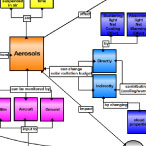|
|
Click Images to Enlarge
|
||||||||
Click Buttons for Presentation Videos & Maps |
About this Workshop:
For this workshop, 12 informal educators from the New England area (including the Seacoast Science Center and New England Aquarium) were matched with ocean and climate scientists from the University of New Hampshire to improve their collective understanding of Earth's climate and ocean systems. [more]
About this Scientist:
Hui Feng's research is in the field of ocean color remote sensing, hydro bio-optics and radiative transfer in optically-complex waters. Specifically, his focus has been on the development of ocean color inversion algorithms to retrieve in-water bio-optical properties, and the evaluation of ocean color atmosphere correction performance in coastal regions using in-situ atmospheric and aquatic optical measurements. A recent research focus involves the sea state bias modeling for altimeter range correction by using global ocean surface wave model and scatterometer data. [more]












